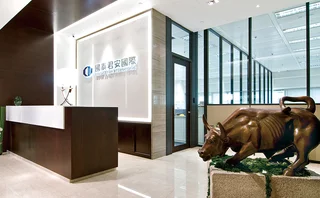
Europe’s pension funds pile into fixed income
Recent surveys have shown that pension funds around Europe are investing more and more of their assets in bonds. Credit examines whether this trend is sustainable

Every issuer and lead manager knows the importance of getting quality investors into the book when trying to place paper. The sight of too many speculative investors queuing up to part with their money can leave some borrowers in a cold sweat, but recent evidence from a number of asset managers showing that European pension funds are beefing up their exposure to bonds at the expense of their equity holdings should calm issuers’ nerves.
Despite the fact that equity markets have rallied strongly over the last 18 months, with the MSCI Europe and the S&P Europe 350 both increasing by almost 40%, and the fact that the beginnings of a protracted rise in interest rates has left many investors pessimistic about future bond returns, pension fund managers are piling more and more of their assets into the fixed-income market.
The results of a survey from the UK’s Investment Management Association (IMA), whose members invest some €10.4 trillion of assets globally, found that pension schemes are selling off their stock holdings and buying into bonds in a bid to better match their assets and liabilities. Indeed, WHSmith’s chairman of trustees, Martin Taylor, suggests that the entire €183 million it is using to plug its pension fund deficit will not be invested in anything else but fixed-income instruments.
IMA chief executive Richard Saunders says: “[Our] survey shows that the UK asset management industry is adjusting to changing client needs and market conditions. The emerging trend of liability-based benchmarking is likely to result in an increased level of bond investment and illustrates [investors’] ability to adapt to a changing environment.”
Europe-wide phenomenon
But the shift is not just a symptom of the UK market. According to the annual report of ATP, the €35.4 billion Danish Labour Market Pension Scheme, one of the largest in Europe, increased its exposure to non-euro denominated bonds to 41% from 26% in the 12 months to January 2004, while slashing its holdings in foreign equities by more than 80%.
These findings are supported by the results of Invesco’s annual European Institutional Asset Management Survey of 146 investors in Belgium, the Netherlands, Luxembourg, France, Germany and Italy. The report reveals that, although investors are concerned about monetary policy tightening, they plan to boost their fixed-income holdings to 55% of their average portfolio. And while many intend to lower their exposure to European and global government bond issuers, a large proportion will plough new money into European corporate, high-yield and emerging market paper.
“On the lookout for higher yields, the surveyed investors say they will focus on investment-grade corporates, high-yield corporates and emerging market bonds,” Invesco says in its report. “And despite the improving market environment, European institutional investors maintained their cautious stance towards equities.”
But pension fund managers are apprehensive. The US Federal Reserve increased interest rates for a second month in a row in August to 1.5%, while the Bank of England’s monetary policy committee pushed rates up to their highest levels since September 2001: 4.75%. And, although the European Central Bank opted to leave its rates unchanged at 2% for the fourteenth consecutive month, the fact that eurozone inflation came in well above the ECB’s 2% ceiling at 2.4% in July suggests that a rise could be imminent.
To combat the effect this has had on corporate bond prices, Richard Hodges, senior investment manager, fixed income at Gartmore Investment Management, is shying away from sector selection and is instead applying a bottom-up approach to buying paper. “Corporate bond prices have risen over the past 12 months and many appear to offer poor value,” he says. “As such we are not focusing on sectors, preferring to pick stocks first and seeing what comes out of the mix.”
The fund’s strategy is to focus on a company’s management and the quality of its business, along with its cashflow and balance sheet. Within telecoms, for instance, he favours Telecom Italia, which is continuing to pay off debt and has an enviable franchise, but trades on a wider spread than other European telecoms. Hodges also likes reinsurer Hannover Re as it appears to have its US asbestos-related liabilities under control and has continued to generate healthy profits in a tough environment.
Hodges adds that although his firm does not dwell on industry sectors, it does select on the basis of credit quality and currently prefers high-yield and crossover bonds. “High-yield bonds and crossover credits, which have fallen from investment grade to junk status, are attractive at present since the benign economic background makes them much more likely to improve their rating in the future,” he says.
But some pension funds are not convinced by the general shift towards bonds and are instead choosing to move their assets in the opposite direction. A survey conducted by Heissmann Consultants of German pension funds and insurance companies with more than €200 billion of assets under management, showed that investors want to cut their bondholdings by 10%, while increasing their equity and alternative assets by 5%.
The consultancy says in a report: “In the medium to long term, participating investors plan to reduce fixed income, cash and money market-type holdings. In contrast, equity investments are set to be increased. In particular, investments in alternative asset classes such as hedge funds, real estate and private equity will be lifted. All the plans indicate that investors’ risk appetite has grown and that their confidence in the economy and in markets is increasing.”
At the same time, the pension scheme of the London Stock Exchange is reviewing its decision to allocate 100% of its assets to bonds over the long term, while Dutch telecom firm KPN is reducing the 60% allocation its pension scheme has to bonds to 50% in an effort to boost returns. Furthermore the €4.2 billion pension scheme of UK retailer Boots, which in a high-profile move switched its entire asset portfolio to long-dated triple-A sterling bonds in 2002, is to push 15% of funds into other asset classes.
Deficits
The good news for treasurers, however, is that these shifts appear to be in the minority. The top 50 European blue chip companies have pension fund deficits in excess of €115 billion, according to research from consultancy Lane Clark & Peacock, while the FRS17 pension scheme deficits of the top 100 firms in the UK stand at £42 billion as of July this year. This makes it difficult for pension fund managers to ignore the argument that they should increase their exposure to bonds and move away from the relative volatility of the equity markets. Such a move may be facilitated by the fact that in July Moody’s global speculative-grade default rate dropped below 3% for the first time since January 1999.
Indeed, the strength of that shift has even prompted Barclays Global Investors, the largest European institutional asset manager, to scan the market in the hope of acquiring a suitable fixed-income house to meet what it expects to be a heightened demand for bonds among its clients.
“There can be very little doubt that bonds are a better hedge for pension fund liabilities than equities,” says Alistair McCreadie, senior European corporate analyst at ABN Amro. He believes that equities are used because there is a widespread belief that this asset class lowers the cost of pension provision and may create value for shareholders. But McCreadie finds this argument illusory. “The adoption of a bond-biased investment strategy will not cure all of one’s pension ails…and they are not the panacea that some may think they are…but for prudential reasons pension funds must hold bonds in preference to equities,” he says.
Only users who have a paid subscription or are part of a corporate subscription are able to print or copy content.
To access these options, along with all other subscription benefits, please contact info@risk.net or view our subscription options here: http://subscriptions.risk.net/subscribe
You are currently unable to print this content. Please contact info@risk.net to find out more.
You are currently unable to copy this content. Please contact info@risk.net to find out more.
Copyright Infopro Digital Limited. All rights reserved.
You may share this content using our article tools. Printing this content is for the sole use of the Authorised User (named subscriber), as outlined in our terms and conditions - https://www.infopro-insight.com/terms-conditions/insight-subscriptions/
If you would like to purchase additional rights please email info@risk.net
Copyright Infopro Digital Limited. All rights reserved.
You may share this content using our article tools. Copying this content is for the sole use of the Authorised User (named subscriber), as outlined in our terms and conditions - https://www.infopro-insight.com/terms-conditions/insight-subscriptions/
If you would like to purchase additional rights please email info@risk.net
More on Structured products
A guide to home equity investments: the untapped real estate asset class
This report covers the investment opportunity in untapped home equity and the growth of HEIs, and outlines why the current macroeconomic environment presents a unique inflection point for credit-oriented investors to invest in HEIs
Podcast: Claudio Albanese on how bad models survive
Darwin’s theory of natural selection could help quants detect flawed models and strategies
Range accruals under spotlight as Taiwan prepares for FRTB
Taiwanese banks review viability of products offering options on long-dated rates
Structured products gain favour among Chinese enterprises
The Chinese government’s flagship national strategy for the advancement of regional connectivity – the Belt and Road Initiative – continues to encourage the outward expansion of Chinese state-owned enterprises (SOEs). Here, Guotai Junan International…
Structured notes – Transforming risk into opportunities
Global markets have experienced a period of extreme volatility in response to acute concerns over the economic impact of the Covid‑19 pandemic. Numerix explores what this means for traders, issuers, risk managers and investors as the structured products…
Structured products – Transforming risk into opportunities
The structured product market is one of the most dynamic and complex of all, offering a multitude of benefits to investors. But increased regulation, intense competition and heightened volatility have become the new normal in financial markets, creating…
Increased adoption and innovation are driving the structured products market
To help better understand the challenges and opportunities a range of firms face when operating in this business, the current trends and future of structured products, and how the digital evolution is impacting the market, Numerix’s Ilja Faerman, senior…
Structured products – The ART of risk transfer
Exploring the risk thrown up by autocallables has created a new family of structured products, offering diversification to investors while allowing their manufacturers room to extend their portfolios, writes Manvir Nijhar, co-head of equities and equity…
Most read
- Top 10 operational risks for 2024
- Top 10 op risks: third parties stoke cyber risk
- Japanese megabanks shun internal models as FRTB bites







